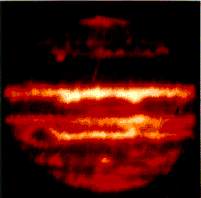This is an infrared image of Jupiter showing regions which are hot.
Click on image for full size
NASA
The Source of Heat from Within Saturn
Frequently in astromony, the luminosity of a star is calculated. The luminosity indicates the energy, and the temperature of the star.
When the luminosity of the outer planets was calculated, that of Jupiter and Saturn was very high, indicating that these planets are giving off a lot of energy, more energy in fact than they are receiving from the sun.
There are several ways in which astronomical objects produce energy from inside. The first is thermonuclear fusion. This method of energy production is reserved for stars. Another method is by way of radioactive material within the ground. This method is at work in most terrestrial bodies.
For the giant planets the method which seems to be at work is the mere fact that energy is given off from when a planetary body is in the process of shrinking together, or collapsing on itself.
The fact that Saturn is still collapsing together indicates that the process of planet formation is still going on. This process is providing the heat from within which causes the unusual motions in the atmosphere.
You might also be interested in:

In many respects Titan is similar to the other icy moons, but Titan is the only icy moon to have an atmosphere that can be compared to other planets'. It is natural to ask how is this possible since Titan
...more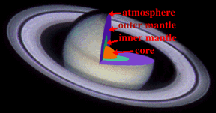
The Giant planets do not have the same layered structure that the terrestrial planets do. Their evolution was quite different than that of the terrestrial planets, and they have less solid material inside.
...more
Astronomers have discovered a bizarre, hexagon-shaped feature in the clouds of Saturn near the planet's North Pole. The feature was first seen in images returned by the Voyager spacecraft in the 1980s,
...more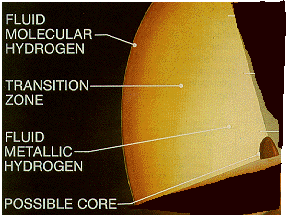
The first liquid layer inside Saturn, immediately under the atmosphere, is the liquid hydrogen layer. The hydrogen atmosphere becomes thicker and thicker, a fog with more and more liquid hydrogen droplets,
...more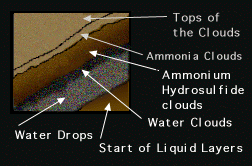
There is no surface to the giant planets, only a gradual transition from the atmosphere, as depicted in this drawing. The hydrogen and helium of which Saturn is mostly composed change to liquid form under
...more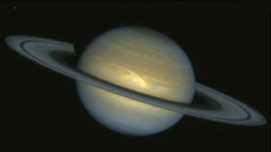
The most important motions in the atmosphere are winds. The major winds in Saturn's atmosphere are the zonal winds which are composed of alternating belts and zones flowing in opposite directions. Belts
...more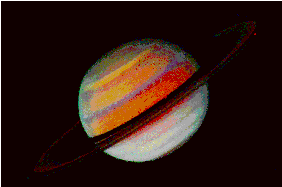
The striped cloud bands on Saturn, like Jupiter, are divided into belts and zones. In a belt, the wind flows very strongly in one direction only. In a zone, the wind flows very strongly in exactly the
...more


